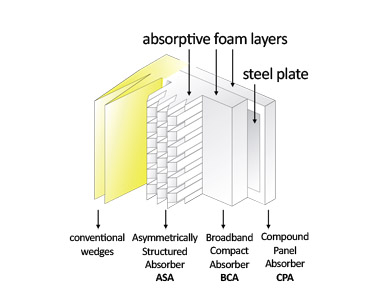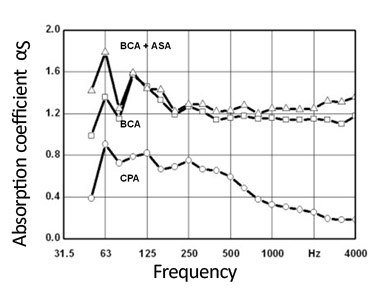General information relating to sound-absorbing linings for acoustic testing and measurement rooms
Sound-absorbing inings for an acoustic testing and measurement room aim to obtain, inside a building, free acoustic field conditions, such as could be obtained outside, in an space being unlimited (but subject to bad weather, which generally does not accommodate metrological practice relating to acoustics e.g. in a research and development - R&D - context).
When they do not include a resonator, the airflow resistance and the thickness are therefore crucial acoustic characteristics of such coverings, which are then fibrous or made of open-cell foam for such applications.
This is why a sound-absorbing lining for an acoustic testing and measurement room is commonly made up of pieces of mineral (e.g. rock or glass) wool, polyester wool or foam of sufficiently low density so that the associated resistivity does not oppose too much the penetration of acoustic waves, even in the case of the important thicknesses which are required for an effectiveness in low frequency according to such a principle of action.
In some cases, absorbent linings for acoustic testing and measurement rooms are in the form of wedges (i.e. pyramid-shaped subsets) while in other cases, compact absorbers or asymmetrical structured absorbers (ASA)are used.
The difference between the first (conventional wedeges) and the last is not only due to their dates of placing on the market (separated by several decades), but also to their length (the sophistication of the geometry of the ASAs allowing a reduction of this fundamental parameter for the layout of laboratories).
As for absorbing linings for testing rooms such as anechoic or semi-anechoic rooms (including: aero-acoustic wind tunnels) are concerned, they generally consists of multilayer modules sometimes (quite often: made of mineral wool or of polyester wool or of melamine foam) often covered by a surfacing (most often: a fiber glass or a polyester cover) and (in many cases) and by a perforated protection (mostly: galvanized or painted steel). A powder coating usually provides the best protection against corrosion: classification up to C5 according to ISO 12944 while providing a visula aspect appropriate for the the context.
In some cases, the frame of the plane absorbing lining in a test room can be made of stainless steel (SS 304, SS 316) or aluminum.
As required, the absorbing lining may be, for some applications, protected by a waterproof surfacing (polyurethane film and for extreme cases: painting).
In order to increase the absorption coefficient in a given frequency range, an intermediate plate (usually made of steel) and also an additional spacing absorbent layer may be inserted into the absorbing linings for test rooms, the performance such absorbing panels then being (partially) based on the effect of resonant membrane (also known as resonator).
The prediction of the performance of plane absorbing linings for testing rooms can be performed with the simulation software SILDIS®.
Verification of acoustic performance of sound-absorbing linings for acoustic testing and measurement rooms can be made in accordance with ISO 354 Acoustics - Measurement of sound absorption in a reverberation room or in accordance with the standard NF EN ISO 10534-1 Acoustics - Determination of sound absorption coefficient and impedance in impedance tubes - Part 1: Method using standing wave ratio.
Comparative performance of sound-absorbing linings for acoustic testing and measurement rooms
The comparative performance of sound-absorbing linings for acoustic testing and measurement room is illustrated below (Faist range), with respect to the two fundamental characteristics:
- thickness (for maximizing the space available inside the room and for minimizing its footprint, all other things being equal)
- random incidence sound absorption coefficient (in a reverberant room)
|
|
|
. |
ITS masters all aspects of the choice of a sound-absorbing lining for an acoustic testing and measurement room.
Spread the word !
 absorbing linings for anechoic chambers
absorbing linings for anechoic chambers absorbing linings for acoustic testing and measurement rooms
absorbing linings for acoustic testing and measurement rooms